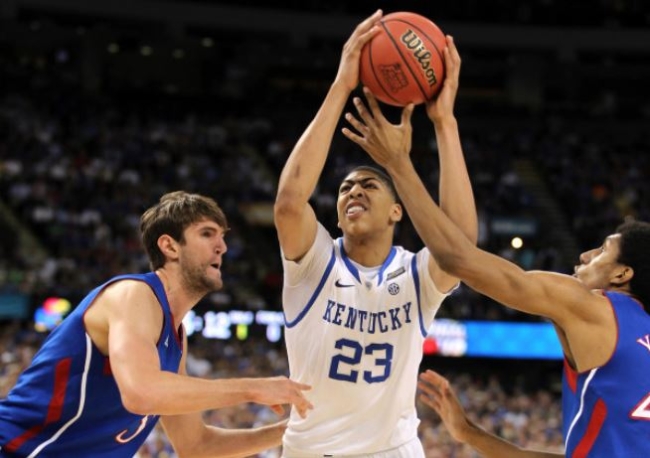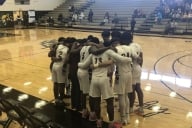You have /5 articles left.
Sign up for a free account or log in.

The University of Kentucky has become a haven for one-and-done players.
Chet White | UK Athletics
Frustrated by what they see as the National Basketball Association’s continued pillaging of underclassmen from their teams, some college basketball conferences warn that colleges will consider making freshmen ineligible to play if the N.B.A. does not change its rule that makes players eligible for the draft at age 19.
Freshman ineligibility is often proposed by those interested in reforming college sports as a way to protect academic integrity and help remediate struggling athletes. It's not often considered seriously by many in the National Collegiate Athletic Association, which voted to make freshman players eligible in 1972.
In recent months, however, the idea has gained traction among some high-level college athletics officials.
The concept came up during a recent National Collegiate Athletic Association Division I board meeting, and the idea was floated during conversations at the N.C.A.A.’s annual meeting last month. For the first time since 2004, the Knight Commission on Intercollegiate Athletics said it may discuss the issue at its public meeting in May. Several conference commissioners have now asked their leagues to consider some version of freshman ineligibility.
“The topic is very serious, and we’ve put a stake in the ground,” Larry Scott, commissioner of the Pacific-12 Conference, said. “We’ve tried to be patient, and the preference would still be for the N.B.A. and its players association to figure out a more progressive approach to the health and well-being of its athletes, but if not, then we are going to look at some ways to address it. That includes the possibility of freshman ineligibility.”
College presidents and conference commissioners this week said that no official proposal has been drafted yet, so it’s unclear if such a policy would include all freshman athletes or only athletes below certain academic thresholds or in specific sports. The conversations so far, though, have largely focused on a blanket policy for all freshman basketball players. The rule would be less about the remediation of underprepared or struggling athletes and more about reconciling broader issues raised by basketball’s so-called one-and-done phenomenon.
Baseball players can join a Major League Baseball team right out of high school but if they choose to go to college, they must stay there for three years; football players can’t join the National Football League until three years after they graduated from high school. The National Basketball Association, meanwhile, requires athletes to be 19 years old and 1 year removed from high school before they can enter the draft. The rule, in place since 2005 after a flood of high school graduates immediately entered the draft over the previous decade, has long been opposed by the N.C.A.A., which sees it as encouraging players to attend college for a year only to comply with the policy.
When Mark Emmert became president of the N.C.A.A. in 2011, he lobbied the N.B.A. to adopt Major League Baseball's rule. He was unsuccessful.
The N.B.A.’s new commissioner, Adam Silver, has said publicly that he wants to increase the league’s minimum age to 20, but he faces opposition from many in the N.B.A.’s union, the National Basketball Players Association. The current age requirement is a compromise between the league’s desire for players to be at least a year removed from high school and the union's desire for athletes to be eligible right after high school.
The current setup has fueled increasing frustration among college coaches, presidents and conference commissioners, who say that some basketball programs are becoming feeder systems for the N.B.A. Students are being awarded scholarships that could go to other players only to put in about a semester’s worth of academic and athletic effort before entering the draft.
“I do think university presidents should in a concerted way appeal to the N.B.A. and make clear that this is not a healthy relationship,” said Nathan Hatch, president of Wake Forest University and former chair of the N.C.A.A. Division I Board of Directors. "The fact that freshman ineligibility is being raised does show how deeply people are troubled by the one-and-done phenomenon. It makes a mockery of our hope that student-athletes are receiving an education. The professional teams don’t want to have to examine high school talent. They can just wait for the cream to rise on the college court. I think many colleges are feeling used.”
Last year, the presidents and chancellors of the Pac-12 sent a letter to the other institutions in the “Power Five” conferences detailing a list of 10 reforms they would like to accomplish soon. Many of the list's goals were achieved in the last year, thanks to the 65 wealthiest programs’ new voting autonomy. One-and-done was number 7 on that list, and it’s among the remaining items the Pac-12 would like to tackle in the next year. Commissioners with the Big 12 and Atlantic Coast Conferences have said they also support considering the possibility of freshman ineligibility for basketball players. The Big Ten Conference went even farther last week, proposing a "year of readiness" for freshman players in both basketball and football.
Not all of those involved in college athletics are so publicly distressed by students leaving early. Some programs have actually been able to use the current system to their advantage. Perhaps no team has better leveraged the one-and-done phenomenon than the University of Kentucky. Under Coach John Calipari, the Wildcats are currently 26-0 this season. In the last five years, the team has reached the Elite Eight and the Final Four and won a national title. In the same time span, Calipari has seen more than a dozen of his underclass players enter the draft.
While Calipari says he is actually against one-and-done and would like to see the N.B.A. move to a two-years-after-high-school rule, he often questions the motive behind colleges’ attempts to change their own eligibility rules. During remarks to reporters last week, he asked why athletes leaving early are singled out as “ruining our college,” while other famous dropouts like Bill Gates are given a pass.
“I will tell you when I look at this, I say ‘What’s right for these kids?’” Calipari said. “Not me, not the school, not the program, not basketball, this animal. What’s right for these kids? If it’s right for them, it’s right for all of us.”
Richard Southall, director of the College Sports Research Institute and an associate professor of sports and entertainment at the University of South Carolina, also expressed doubts about the reasoning behind adopting a freshman ineligibility rule. He dismissed recent conversations about the subject as “good media relations.”
“It’s indicative of the new autonomy movement where everything is supposedly up for revision,” Southall said. “This sort of discussion about changing the model seems to come up periodically. It’s a rebranding. It reframes the discussion and strengthens the narrative that these athletes really are students. It’s a smoke screen. Any way that commissioners can get the focus away from the idea that players should be employees makes good business sense.”
Gerald Gurney, president of the Drake Group, a faculty organization concerned with the role of academics in college athletics, said that if colleges are really concerned about improving the academic integrity of its basketball programs, a blanket policy making all freshman basketball players ineligible would not do the trick. The Drake Group suggests that colleges require all athletes whose academic profile does not fall within one standard deviation of the general student body -- a metric similar to what is already used by teams in the Ivy League -- to take their freshman year off as a “year of readiness.”
The time demands on athletes who sat out their freshman season would need to be lowered drastically, Gurney said. Despite N.C.A.A. rules limiting time demands on athletes to 20 hours a week, N.C.A.A. studies consistently show that football and basketball players dedicate more than 40 hours a week to their sport.
“The focus needs to be on the institution and the selectivity of the institution,” Gurney said. “If a student is more than one standard deviation below the average student at that school, then the student needs to sit out a year. But that ‘freshman ineligibility’ needs to be paired with a time commitment of no more than 10 hours a week and the student should spend that year in remediation.”
An upcoming change to N.C.A.A. rules is already designed to help athletes in this way. In 2016, the minimum high school GPA the N.C.A.A. requires for players to be eligible as freshmen will increase from 2.0 to 2.3. High school athletes must complete 10 of the 16 required core courses before their senior year of high school. Those who don’t meet the requirements will have to redshirt (or sit out from competition) in their freshman season. Time demands could still be an issue, however, as the freshmen will still be allowed to participate in practice.
This is an update to an existing rule commonly known as Proposition 48, which has been challenged through lawsuits claiming that it discriminates against minority athletes by using metrics, such as SAT scores, on which white and Asian students on average outperform their black and Latino peers and wealthy students typically score higher than low-income students. The Pac-12's Scott said freshman ineligibility, if based on academic markers, could potentially lead to similar legal disputes.
The policy could also lead to extra expenses, Scott said, as some coaches may hope for additional scholarships to help round out teams that now rely on freshman players. Frustration over high costs -- of funding separate freshman teams and awarding scholarships to players that weren’t playing -- helped lead to freshmen first being allowed to play basketball and football in 1972.
Michael Aresco, commissioner of the American Athletic Conference, said that he has heard some “rumblings about freshman ineligibility, but it’s not on the front burner” for colleges outside of the wealthier, autonomous Power Five conferences. Aresco plans on discussing the issue with the colleges in his conference in the coming weeks. He said he would not support a blanket policy.
“The vast majority of freshmen are academically prepared, and the vast majority of freshmen are not leaving to play in the N.B.A.,” he said. “I understand there’s this idea that freshman ineligibility could somehow restore integrity and credibility in college basketball, and I understand the desire to be viewed as academically centric. But you’d be penalizing thousands of freshmen for a few dozen one-and-dones.”








